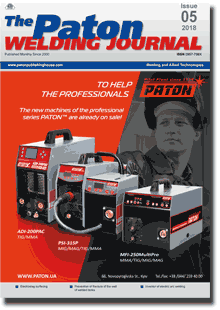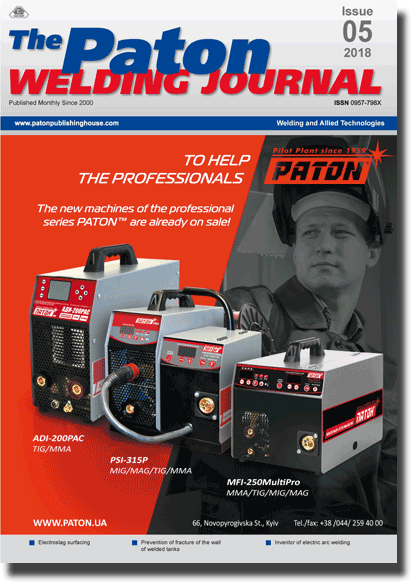| 2018 №05 (07) |
DOI of Article 10.15407/tpwj2018.05.01 |
2018 №05 (02) |

The Paton Welding Journal, 2018, #5, 2-6 pages
Effect of amplitude and frequency of plasmatron oscillations on chemical and structural inhomogeneity of metal deposited by plasma-powder method
I.A. Ryabtsev1, E.F. Pereplyotchikov1, I.A. Bartenev2, G.N. Gordan1, I.L. Bogajchuk1 and L.M. Kapitanchuk1
1E.O. Paton Electric Welding Institute of the NAS of Ukraine 11 Kazimir Malevich Str., 03150, Kyiv, Ukraine. E-mail: office@paton.kiev.ua 2Karaganda State Technical University 56 Mira Ave., 100027, Karaganda, Kazakhstan. E-mail:igor_svar@mail.ru
Effect of amplitude and frequency of plasmatron oscillations on formation of deposited beads, nature of base metal penetration as well as structural and chemical inhomogeneity in zone of joining of deposited and base metals was investigated. The plasmatron oscillation frequency has the largest effect on bead shape and its microstructure, increase of amplitude rises bead width and decreases its height. Effect of plasmatron oscillation frequency on nature of base metal penetration and chemical and structural inhomogeneity in zone of joining of base and deposited metals along surfacing direction was also investigated. In deposition with plasmatron oscillations there is a wavy configuration of interface of deposited and base metals in longitudinal direction with higher frequency of projections and cavities, which repeats plasmatron oscillation frequency. It is determined that increase of plasmatron oscillation frequency on projections as well as cavities in fusion line promotes decrease of deposited and base metals stirring and content of main alloying elements rapidly changes. 6 Ref., 11 Figures.
Keywords: plasma-powder surfacing, oscillations of plasmatron, amplitude and frequency of oscillations, base metal penetration, chemical and structural inhomogeneity, formation of deposited metal
Received: 26.03.18
Published: 07.05.18
References
- Gladky, P.V., Frumin, I.I. (1965) Plasma surfacing. Svarka, 3, 23–27 [in Russian].
- Vajnerman, A.E., Shorshorov, M.Kh., Veselkov, V.D., Novosadov, V.S. (1969) Plasma surfacing of metals. Leningrad, Mashinostroenie [in Russian].
- Vajnerman, A.E., Zakharov, V.F., Syutiev, A.N. (1975) Surfacing with constricted arc of stainless steel on low-carbon and low-alloy steels. Leningrad, LDNTP [in Russian].
- Pereplyotchikov, E.F., Ryabtsev, I.A. (2007) Plasma-powder surfacing in reinforcement engineering. Kiev, Ekotekhnologiya [in Russian].
- Gladky, P.V., Pereplyotchikov, E.F., Ryabtsev, I.A. (2007) Plasma-powder surfacing. Kiev, Ekotekhnologiya [in Russian].
- Ryabtsev, I,A., Senchenkov, I.K. (2013) Theory and practice of surfacing operations. Kiev, Ekotekhnologiya [in Russian].
Suggested Citation
I.A. Ryabtsev, E.F. Pereplyotchikov, I.A. Bartenev, G.N. Gordan, I.L. Bogajchuk and L.M. Kapitanchuk (2018) Effect of amplitude and frequency of plasmatron oscillations on chemical and structural inhomogeneity of metal deposited by plasma-powder method. The Paton Welding J., 05, 2-6.The cost of subscription/purchase order journals or individual articles
| Journal/Currency | Annual Set | 1 issue printed |
1 issue |
one article |
| TPWJ/USD | 384 $ | 32 $ | 26 $ | 13 $ |
| TPWJ/EUR | 348 € | 29 € | 24 € | 12 € |
| TPWJ/UAH | 7200 UAH | 600 UAH | 600 UAH | 280 UAH |
| AS/UAH | 1800 UAH | 300 UAH | 300 UAH | 150 UAH |
| AS/USD | 192 $ | 32 $ | 26 $ | 13 $ |
| AS/EUR | 180 € | 30 € | 25 € | 12 € |
| SEM/UAH | 1200 UAH | 300 UAH | 300 UAH | 150 UAH |
| SEM/USD | 128 $ | 32 $ | 26 $ | 13 $ |
| SEM/EUR | 120 € | 30 € | 25 € | 12 € |
| TDNK/UAH | 1200 UAH | 300 UAH | 300 UAH | 150 UAH |
| TDNK/USD | 128 $ | 32 $ | 26 $ | 13 $ |
| TDNK/EUR | 120 € | 30 € | 25 € | 15 € |
AS = «Automatic Welding» - 6 issues per year;
TPWJ = «PATON WELDING JOURNAL» - 12 issues per year;
SEM = «Electrometallurgy Today» - 4 issues per year;
TDNK = «Technical Diagnostics and Non-Destructive Testing» - 4 issues per year.


